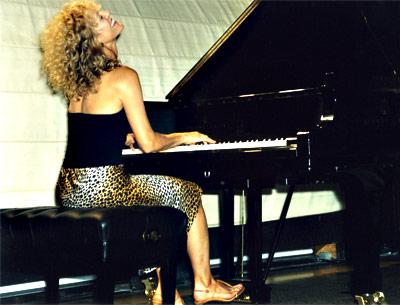Judy Carmichael Finds Her Voice

With her new album, “I Love Being Here With You,” Judy Carmichael has taken her career in a new, yet familiar, direction.
The stride pianist’s exemplary musicianship, heard on albums including “Old Friends,” “Basie Called Her Stride,” and “High on Fats and Other Stuff,” and her rich voice, heretofore mostly heard on her radio show “Jazz Inspired,” combine in a new way. On “I Love Being Here With You,” released on Tuesday and available at her Web site, judycarmichael.com, Ms. Carmichael, who lives in Sag Harbor, sings on all 11 tracks, representing the work of composers including Cole Porter, Rodgers and Hart, and Duke Ellington. She does not play the piano.
Ms. Carmichael will sing, and play the piano, at a champagne lunch recital on Sunday at noon at the American Hotel in Sag Harbor. Proceeds from the recital, in which Chris Flory and Harry Allen will accompany her on guitar and tenor saxophone, will be donated to the artist’s foundation, Jazz Inspired, Inc. Tickets are available at her Web site. The $150 price includes the champagne lunch, recital, tax, and tip, and is tax-deductible.
In a telephone interview from her hotel in Nashville, where she was set to perform at the McAfee Concert Hall at Belmont University last week, she mused about the complementary and contrasting elements of instrumental and vocal performance.
“The main thing is it’s tied into another direction of music that I really like,” Ms. Carmichael said of singing. “I wanted to sing some things I don’t play, in a different style from what I play. It was great to think about nothing but singing.”
Of her vocal influences, “I always liked people that sang the melody and interpreted the lyrics and told the story,” Ms. Carmichael said. “I was obsessed with old movies, so I was a big Fred Astaire-Ginger Rogers fan, and all the musicals of the era.” Astaire “had great lyrics and interpreted them well.”
Peggy Lee is among her favorite jazz musicians, a “super-cool instrumentalist who happens to be singing,” while Shirley Horn and June Christy are also counted among her influences. “Basically, the ones that swing and are very connected to the emotion of it,” she said of her favorite singers.
The road to singing was long, difficult, and carefully tread. While in high school, her vocal cords hemorrhaged, and during college a few nodules were removed. “So I never even tried to sing — I didn’t think I could,” she recalled. Five years ago she began singing, privately, and on her previous release, “Come and Get It,” she sang on three tracks. “I thought I could do it, but wanted people I really respect to say yes, you should continue with this.” She played a gig at Feinstein’s in New York, and queried “a handful of musicians I could trust, that I knew would tell me the truth. They all said, ‘You have to do it, you should go forward.’ ”
Recording “I Love Being Here With You” at Nola Studios in New York, where “Jazz Inspired” is also taped, Jim Czak, an engineer, provided additional guidance. “He was very encouraging, but also talked about some strategies while in the studio — not stylistically, but how one records vocals well: How other people recorded, the pacing of how they did it,” Ms. Carmichael said. “I learned a lot from him.”
Earlier in her career, her prowess on the piano surprised and impressed many jazz legends, some of whom championed her abilities and opened doors to wider recognition. “I knew Sarah Vaughan, and spent a lot of time with her in my 20s,” she said of the late singer. The drummer Harold Jones, who performed on Ms. Carmichael’s first record, played one of her recordings for Vaughan, with whom he also performed. “She got up and started dancing to it,” Ms. Carmichael said. “She was very nice, encouraging, invited me to parties at her house.” She called Vaughan “one of the greatest improvisers I’ve ever heard. Every time she went out it was different.”
At her first jazz festival, Ms. Carmichael remembered, Carmen McRae heard her sound check and demanded that “the guy playing stride piano” be brought to her. “She looked at me, a little irritated, and said, ‘What do you want?’ She thought I was a big guy. She loved that here was this skinny blond girl. And she was known for being cranky, but with me she was really supportive.”
These African-American artists, Ms. Carmichael felt, “loved that I broke the stereotype. I think they had experienced so much prejudice themselves that they loved watching all the preconceived notions, when people would meet me, and proving them wrong. So they became big supporters.”
Singing, the musician said, is a point of pride, and some of the 20th century’s most revered vocalists were in fact exceptional instrumentalists. Vaughan, she noted, had been a second pianist for Earl Hines. Nat Cole was a pianist, and Ella Fitzgerald was said to be “a burning harmonica player.”
“Usually, you can make a living in jazz as a bad singer more easily than as a great instrumentalist,” she said. “I didn’t want to be just another instrumentalist who was an okay singer, or be perceived as doing it for commercial reasons, which I am not.”
Ms. Carmichael plans to perform some songs from “I Love Being Here With You” at Sunday’s recital, which will support both her radio show and educational programs. On “Jazz Inspired,” which is also available as a podcast from Apple’s iTunes Store, Ms. Carmichael interviews performers and other creative professionals ranging from the singer Stacey Kent and the late pianist and radio host Marian McPartland to Seth McFarlane, creator of animated television shows including “Family Guy” and “American Dad.”
“I wanted to do something different from usual music shows and keep me interested too,” Ms. Carmichael said. The show is also “a way to bring people into jazz that might not be familiar, and talk to a broad range of creative people about inspiration and creativity. I’ve gotten really well-known people who don’t have to do a show and love having a conversation with another artist, and also get to feature people who would never get an hour on NPR but should, because they’re tremendously accomplished.”
“Jazz Inspired,” she said, is downloaded five to six thousand times each week. Wearing many hats — producer, executive producer, fund-raiser, editor, and hostess — has been both challenging and rewarding. “Nobody tells me who to have on the show,” she said. “It’s harder in some ways because I don’t have a bigger backing, but I have a lot more freedom.”

